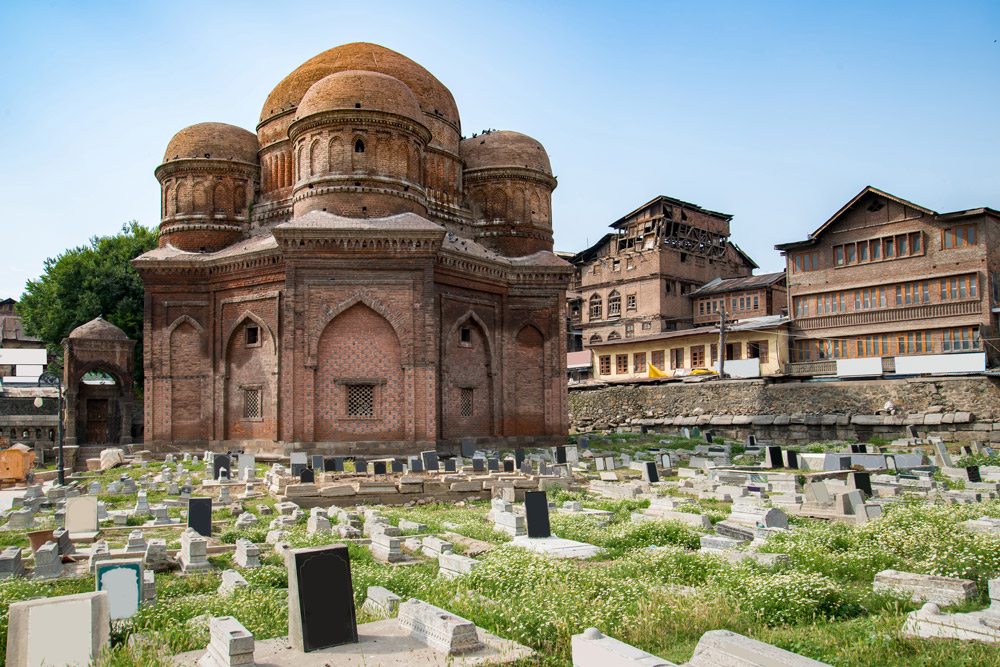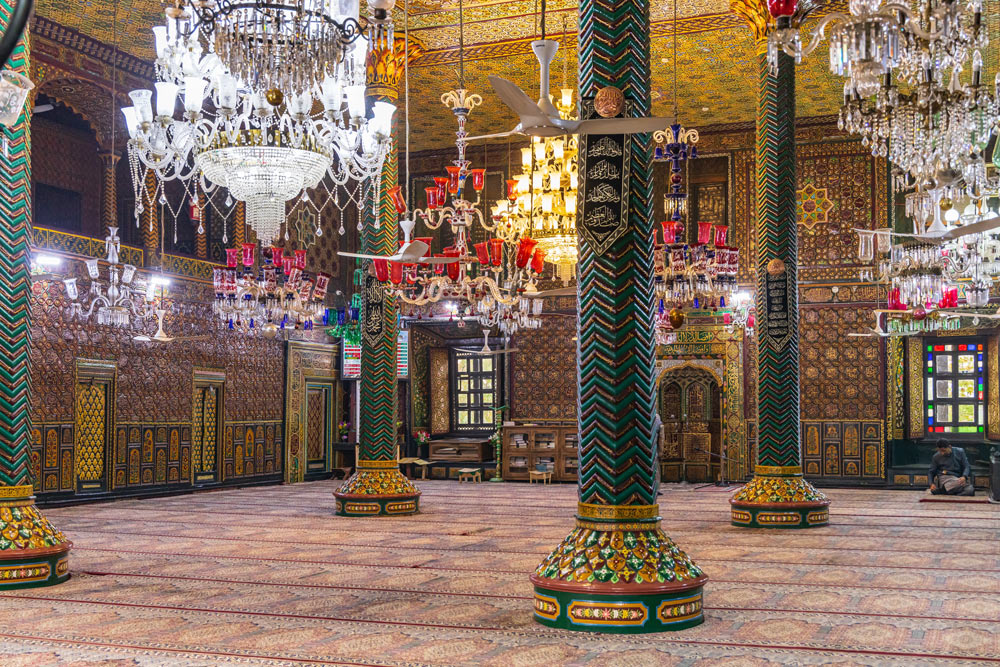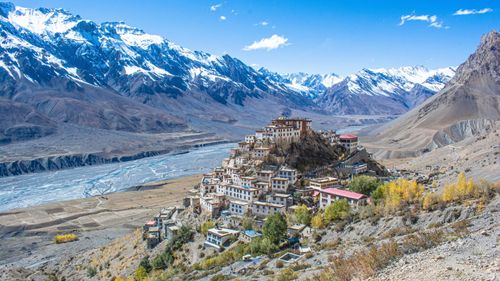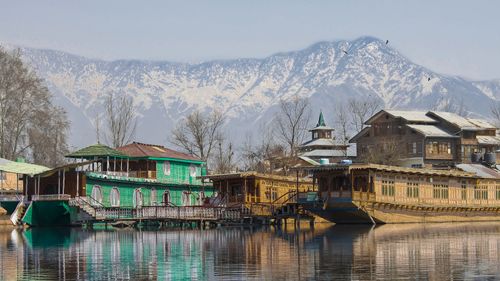Sacks of scarlet Kashmiri red chillies, bags of exotic spices from saffron to dried cockscomb flower used to colour dishes naturally, mounds of single pod Kashmiri garlic, dried dandelion, dried fruits and nuts like figs and walnuts. The bustling Nowhatta Market around this part of Old Srinagar is a visual feast. Not many venture into the old part of Srinagar, confining themselves to Dal lake, for reasons of safety and security. But this is where the soul of the city lies.

We start exploring the old town of Srinagar at the Jama Masjid—located in Nowhatta and built in 1400, by Sultan Sikandar, father of Zain-ul-Abidin, Kashmir’s most famous sultan, and rebuilt after a fire by Emperor Aurangzeb in the 17th century.

I love the architectural style which is uniquely Kashmiri, with a green pyramidal roof and pagoda style minarets and 370 pillars of the chinar tree, holding it up that can supposedly accommodate more than 33,333 people at a time, and an inner courtyard lined with chinar trees and ponds. Reminiscent of Chinese temples, this style of mosques was prevalent before domes became an architectural practice. The absence of Saracenic features in this architecture is attributed to a more peaceful transfer of power from Hindu to Islamic rulers.
The old city is on both sides of the river Jhelum connected by as many as seven wooden bridges. Many of the houses here are climate-friendly built of wood and bricks, as well as earthquake-resistant with timber runners resting along load bearing walls. Multi-storied high houses that housed large families—replete with fretworked eaves, hanging bay windows and cantilevered balconies called dub—lean precariously over narrow alleys with women in phirans and men in skull caps walking in the streets, vendors selling fruits, and the resonant strains of the azaan (call for prayer) ringing from the top of the minarets. Every street is arranged into mohallas, devoted to a particular craft from embroidery to copper wares.
Most lanes branch off at right angles to the river Jhelum harking back to the days when everything was transported by water. Many of the beautiful wooden homes once belonged to the Kashmiri Pandits who abandoned them in the civil conflict, and today they lie derelict and crumbling. Bridges in those days were built by pinning down huge logs of deodar wood with sand to make a base. Today some of them still survive.

Walking down a narrow alley, we reach the bulbous Byzantine brick and mortar domes of the 15th century Budshah Tomb, which was built by Sultan Ghiyas-ud-Din Zainul Aabideen—who is popularly known as Budshah—for his mother. Embellished with blue tiles, it was an oddity in the times of wooden architecture in Kashmir and influenced by Persian architecture and Timur’s Tomb in Uzbekistan.
“The king who ruled for fifty years was known for his religious tolerance and public welfare activities and promoted Sanskrit, Persian, and Arabic languages. He also engaged craftsmen and artisans from Samarkand to train the locals in different arts from carpet weaving to papier mâché,” explains our guide Abdul Majid. Today he also lies buried in one of the tombs here, alongside his wife and children.

My favourite is the Khanqah-e-Moula, also known as Shah-e-Hamadan Masjid, a shrine to Persian mystic Mir Sayyid Ali Hamadani who brought Islam to the valley. Situated on the right bank of the river Jhelum, between the Fateh Kadal and Zaina Kadal bridges, it was first built in 1395 AD.
It is a stunning example of Kashmiri wooden architecture, with lacquered khatamband (wood panelling) made of walnut or deodar with their invisible joinery, antique chandeliers, rich Kashmiri carpets on the floors and interiors decorated with vibrant green and gold papier mâché. Non-Muslims (and women) cannot enter the main hall but can peek in from a window at the ornate painted interiors. I walk around the shrine, looking at women tie little scraps of cloth around a window, as they make a wish, with their eyes closed.
Across the shrine, in a crumbling brick building, is the 200-year-old shop that belongs to Abdul Aziz Kozghar. The musty shop that dates back to 1820, has been carried on by one family of unanis, who made pure distilled rose water, learning the method from their Central Asian ancestors. Inside the dim shop are dusty shelves lined with vintage glass bottles and decanters, and old calendars. Pure rose water has long been used in Kashmir in mosques as a blessing, in weddings and in making sherbets. The Kozhgars also sold medicinal syrups and remedies for stomach problems.
We pass communal bakeries called kandurs that have Central Asian influences and sell fresh bread hot from the wood fire tandoor ovens—from crisp golden girda and paper thin unleavened lavasa to flaky puff pastry called baqarkhani with a sprinkling of sesame seeds on top. “It’s a tradition in the valley that we never make these breads at home, we just take a wicker basket to the bakery in our neighbourhood and pick up freshly baked bread every morning to be relished with a cup of nun chai (pink, salty tea),” explains Majid. The kandurs are also where people meet and socialise and exchange gossip.
We walk through the maze-like Maharaj Ganj where every shop is filled with copper vessels and utensils from samovars (a tea kettle with embers burning inside) carved with chinar leaf designs to ice cream cups, flower vases, and even bath tubs. Tall samovars used for brewing the local kahwa and other vessel hang from shop fronts. “No matter how much modern crockery we have, at least some copper platters, trays and samovars find their way into a bride’s dowry,” says Majid.
I realise that it’s the small details like the wooden Pinjra shutters and distinctive slender Maharaji bricks that are enchanting. Abdul tells me that there are over 30 designs of windows in Kashmir and you can see most of them in Old Town. “Our old houses were so ingeniously designed that they remained cool in summer and warm in the winter and were built taking into account the seismology of the state. We can only hope that they are preserved and conserved so that the future generations can enjoy their heritage,” says Abdul.
Srinagar Fact File
Where to stay: For an authentic experience, stay at Nadis hotel–a boutique hotel with local food and a lovely garden overlooking the mountains.
Eat: Eat a typical Wazwan feast, try local breads at a kandur, and have local Kawha and nun chai.
Shop: Crewel-work shawls and bags, local saffron , walnut wood carvings, papier mache, and carpets.






